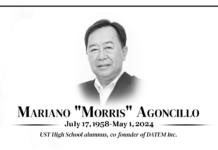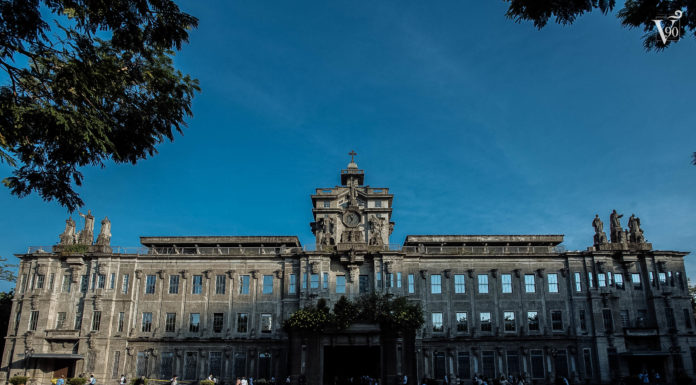AUTHORITIES tightened security in and around the University as over 6,000 examinees trooped to the campus to take this year’s bar examinations.
The Philippine National Police (PNP), together with the explosives and ordinance, and mobile units, deployed policemen at different areas outside the University, while security personnel from the Supreme Court and Court of Appeals, National Bureau of Investigation, Police Security Protection Group, Emilio Aguinaldo College-Police Community Precinct, and UST Security Office took charge on the campus.
The Supreme Court has also banned “bar operations”—activities like putting up streamers, holding sendoffs, and forming cheering squads—on campus.
“Definitely, we will no longer allow [bar operations]. We won’t be complacent even though the first Sunday [of the exams] was peaceful,” bar exam coordinator May Rachel Nolasco said in a personal interview. “We’re really planning to implement stricter [and] full-force [security measures], especially on the last day.”
Traffic personnel from the PNP, Metropolitan Manila Development Authority, and the Manila Traffic and Parking Bureau, assisted by officials of Barangays 401 and 402, directed traffic flow on Lacson Avenue and España Boulevard, whose southbound portion was reduced two lanes to accommodate the crowd.
The Supreme Court said on its website that all roads surrounding UST would remain open to traffic during the bar exams on four Sundays of November, as ordered by Associate Justice Roberto Abad, chairman of the 2011 committee on bar examinations.
Parking on streets surrounding UST is also prohibited during the bar exams period.
Security officials refused to disclose the number of security personnel displayed due to “confidentiality,” but UST Security Office chief Joseph Badinas said they added 20 personnel from the University to beef up campus security.
“We [at the UST Security Office] would just follow and support whatever security operations the Supreme Court plans to implement,” he said.
Only bar examinees with notices of admission were allowed to enter the campus last Nov. 6 and 13. Firearms, cameras, tape recorders, cellphones, and other electrical gadgets were prohibited.
The Main Building, San Martin de Porres, Benavides, and St. Raymund de Peñafort buildings were used as exam venues.
This year’s number of examinees is 6,200 or 18.74 percent higher than last year’s 5,308. The highest recorded number was 6,364 in 2008.
All University gates will be closed during the exams except for P. Noval Street and Lacson gates to provide access to the Santisimo Rosario Parish Church and the UST Hospital, respectively.
Barricades were placed at the open field and around the church and the hospital facing the Main Building to prevent people from roaming around the campus.
The Tan Yan Kee Student Center will remain closed to students on all Saturdays and Sundays of November to give way to the operations of exam facilitators, according to a memorandum issued by Assistant to the Rector for Student Affairs Evelyn Songco last Oct. 12.
Exam changes
This year’s bar exams were moved from September to November, and in UST for the first time in more than two decades. Multiple-choice tests were also included in the bar exams for the first time.
“[The schedule was transferred] to give ample time for us (bar facilitators)—including the examinees, law schools, and review centers—to prepare for this year’s new system,” Nolasco said.
Exams last Nov. 6 covered Political and International Law, Labor and Social Legislation, and Taxation, while exams last Nov. 13 covered Civil Law and Mercantile Law. On Nov. 20, the exam will cover Remedial Law, Legal Ethics and Forms, and Criminal Law, and on Nov. 27, Trial Memorandum and Legal Opinion.
Multiple-choice examinations will account for 60 percent of the candidates’ final grade, while essay-type examinations will weigh 40 percent. Only exams scheduled on the last day do not include multiple-choice format.
Last year, 47 people were injured after a bomb blast on the final day of the bar examinations at De La Salle University, the exam venue for more than 10 years. Raissa Laurel, a law student from San Sebastian College-Recolletos, lost both legs, while Joanna Ledda, a law student from San Beda College, lost her left leg.
La Salle declined to renew its memorandum of agreement with the Supreme Court to again host the bar exams, but Nolasco said last year’s bombing incident has nothing to do with the relocation of exam venue.
“UST has the best facilities of all the possible venues we have chosen from,” she said.
Other venue choices include New Era University, Adamson University, Philippine International Convention Center, and SMX Convention Center.
Nolasco said the decision whether UST will still host the bar exams next year is yet to be decided by Associate Justice Martin Villarama, chairman of the 2012 committee on bar examinations, because the memorandum of agreement is renewable every year.
Civil Law is sixth
Meanwhile, the Faculty of Civil Law, the country’s oldest law school, is only sixth in the latest ranking of law schools in the Philippines, but was still awarded as an “Outstanding Law School” by the Legal Education Board (LEB) last Nov. 11.
By the LEB’s reckoning, Civil Law is sixth on the list of Top 10 law schools based on bar examination results in the last 10 years.
UST got a 10-year average passing-rate of 60.22 percent, behind Ateneo de Manila University (89.03) at first place, San Beda College (85.74 percent), University of the Philippines-Diliman (79.84 percent), Ateneo de Davao University (64.99 percent), and University of San Carlos (61.23 percent).
The University failed to get the award for Excellence in Legal Education, which is only given to the top five law schools.
Civil Law Dean Nilo Divina also received a plaque for being an “Outstanding Law Dean.”
Placing behind UST are Arellano University (42.90 percent), Xavier University (38.90 percent), Far Eastern University (33.14 percent), and University of San Agustin (31.63 percent).
The awarding ceremony was held at the Manila Pavilion Hotel, coinciding with the second anniversary of LEB, which supervises law schools.
Justices of the Supreme Court and the appellate courts, government officials, and officers of the Philippine Association of Law Schools, Philippine Association of Law Professors, and Integrated Bar of the Philippines attended the event. Rafael L. Antonio and Reden D. Madrid














